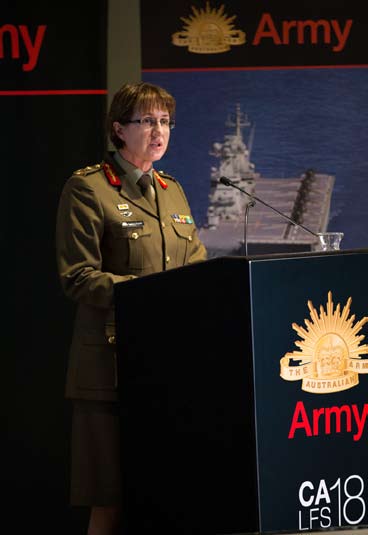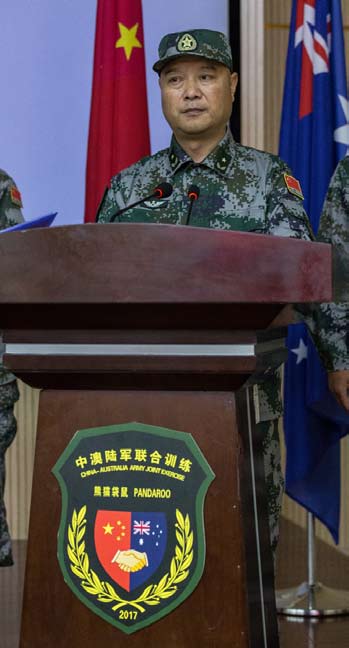Major General Kathyrn Toohey, AM, CSC
Head Land Capability
‘Good morning Ladies and Gentlemen,
‘I would like to acknowledge the traditional custodians of the land on which we are meeting today, the Kaurna people, and pay my respects to their elders, both past and present.
‘It is my pleasure to appear first on this panel of distinguished speakers.
‘Yesterday I spoke at the science and technology conference with two esteemed colleagues—my equivalent in the UK, Major General Chris Tickell, and the Swedish Chief of Army, Major General Karl Englebrektson. Despite coming from very different parts of the world, we all remarked on the similar challenges facing our three armies.
‘Like the UK and Swedish armies, the Australian Army is looking to technology to provide us with an advantage that helps us to win joint land combat. However, while technology has become a focal point of our modernisation efforts, we are careful to never forget that technology is not the end of what we do, but an enabler for what we do.
‘Since history began, societies and nations have used land power to achieve strategic outcomes. Land power has generally been employed as the force for decision. And, yet against the large platform and technology focus of our respective navies and air forces, it would seem armies have some difficulty in establishing a simple narrative of their joint contribution.
‘I was interested to hear the Swedish Chief of Army say that the Swedish Air Force narrative is simply 120 - 120 Gryphons. In Australia, we sometimes joke that the Royal Australian Air Force has a similarly simple narrative: 102 - 102 JSFs (Joint Strike Fighters).
‘This group knows land power provides something the other services cannot – persistent presence on the land. Increasingly through technology we are able to provide effects into other domains, but persistent presence on land remains our unique contribution. Ultimately, the land remains the vital ground being simply ‘where the people live’, and indeed where our air forces and navies are based too.
‘This week it has been widely acknowledged that we are in a period of significant and rapid technological change. New devices and methods are emerging that will change how land forces fight. Regardless, persistent presence will continue to matter, and the need for soldiers to go forth amongst the people is not going away any time soon.
‘New technologies offer land forces both opportunities and challenges to how presence can be achieved.
‘At the top of my list is Robotics and Autonomous Systems or RAS.
‘Robotics offers the potential to enhance or augment the dull, dirty and dangerous tasks undertaken by our people, and possibly, to replace people in these tasks altogether. Such tasks include: high risk searches, close reconnaissance, long term persistent surveillance, route clearance and counter-IED (Improvised Explosive Devices).
‘Robotics may also provide a means for Army to generate scale and mass, supplementing our people to achieve an effect out of proportion with our relative size. Yet I also know that such an advantage may prove to be fleeting.
‘As robotics spread, other nations will have the ability to make their own. The critical point of difference will not be the number of robots but the quality of the algorithms that control their operation. The key to creating an asymmetric robotic advantage lies in the intellectual superiority of their human designers.
‘While robotics offer land forces many benefits, I do have some concerns. Can robots exert the essential presence that land forces are called on to provide? How will local populations react to a robot force in their midst? We have no information to answer these concerns, but they will need to be addressed if robotics is to fulfil its potential.
‘Other new technologies also show merit. Additive or 3D manufacturing has the potential to enable the production of spare parts through to complete systems including when deployed on operations. By embracing the promise of 3D manufacturing, we may be able to deploy fewer support staff while not compromising our ability to maintain the essential presence that underpins the purpose of armies. 3D manufacturing may allow a relatively small force such as the Australian Army to offset its lack of mass by making its deployed force more efficient.
‘By exploiting media technology even small groups can project their influence to a far greater audience than their size would suggest. Land forces will have to contest the information domain—indeed, we already do. That said, we need to reinterpret this contest. It is as much about claiming a cognitive space in the minds of people as it is about securing a geographic space. Land forces don’t have extensive experience in contesting a cognitive presence, but it is vital that we learn how.
‘To embrace the opportunities technology offers we must encourage disruption. We must not recoil from its challenge. Those who can think laterally, think differently, must be allowed to do so. We must be brutally honest as we think about new opportunities. There can be no sacred cows when thinking about the future of land warfare.
‘To manage the potential and challenges of these technologies, land forces will have to address fundamental questions of how they think about and prepare for the future fight:
- As autonomous machines enter the ranks in greater numbers, how will we address the necessary changes in our organisational cultures so that cohesion is not lost? The integration of human and intelligent machines poses challenges of trust, acceptance, and loyalty. These qualities have been instrumental to building military power since the Roman Empire and the Han Dynasty were at their peaks of influence. They remain so today.
- Will those parts of the land force that currently dominate the organisation be willing to give way to other arms that will grow in importance and utility? Will the arms corps cede status to the information warfare soldier? The history of transitions suggests that the old guard will fight to retain its position. Major General JFC Fuller, the leading theorist of armoured warfare during the inter-war period, was considered an odd fellow by his horse-riding peers and overly bookish by his superiors. His brilliance, to Britain’s loss, was not accepted by those who insisted on the maintenance of the old ways.
- How will our environment influence the use of these new technologies? The Indo-Pacific Region is dominated by the maritime and littoral environment, large regions with restricted and heavily vegetated terrain and growing urbanisation. The region’s complex physical environment will continue to present manoeuvre challenges for land forces.
- What is the right balance of investment in these new technologies? What should be the basis of our future force structure design: Starship troopers, big battalions or both? Or, in other words, what is the balance between the small, many and smart versus the few and the exquisite?
- We must also remember that the other side always catches up. They may even be ahead: ISIS (the Islamic State in Iraq and Syria) has consistently demonstrated the superior skill with which it exploits social media. Technology is never a magic bullet that provides an eternal advantage. Soldiers, and their societies, will eventually develop countermeasures or invent superior technologies of their own that negate ours. With increased interconnectedness comes the cyber threat, with the increased use of space comes the counter-space threat. It is a never-ending dance. How do we prepare for and, indeed, participate in this dance?
‘I’ve saved what I believe to be the most critical concern for last:
- How do we prepare our workforce for the high tech future?
- How will we educate and train our people and adapt our generalist
- approach to workforce to a more specialist one?
- How do we assure that today’s soldiers are open to the opportunities
- afforded by new technology?
- How do we compete or possibly collaborate with other organisations who want and need the same skilled people that we do?
‘The potential of a new technology is not always obvious. The opportunity can only be realised after time, suitable thinking and extensive experimentation.
‘Today, more than ever, armies need creative, divergent thinkers and technology thought leaders. As always, senior leaders need to be prepared to listen to the clever people within their ranks. Disruption and risk-taking should be welcomed, and the status quo must be called upon to justify the continuation of its position.
‘Fortunately, the Australian Army has strong intellectual foundations in place. There is already a vibrant and exciting debate taking place about tactical, operational and strategic opportunities. Appropriately this debate is happening in the spaces of the information age—on blogs and digital forums.
‘The Chief of Army’s Accelerated Warfare is a call to think differently and disruptively. We are thinking deeply about our future use of technology with an eye to understanding its advantages as well as its vulnerabilities, and to how it can be best integrated into our existing and future force structures.
‘Militaries have gone through periods of disruptive technology before. For example, the years between the two World Wars were ones of particularly intense innovation: the mechanisation of land forces, the triumph of naval aviation and the development of strategic bombing overturned the established order. I suspect we are entering a period of similar intensity in technology driven innovation.
‘But even with great change there is also great continuity. Land forces will continue to send soldiers into the mud, much as the Romans did, although robots may march at their side. In doing so, soldiers will continue to offer government with the capability that only they can provide— persistent presence on the land, and amongst the people.’

Figure 30. Major General Kathryn Toohey addresses CALFS 18. (Image: DoD)

Figure 31. An Australian soldier trials wireless systems technology (Image: DoD)

Figure. 32. Major General Wan Suocheng of the Chinese PLA welcomes Australian Army participants to Exercise Pandaroo in Kunming, China. The bi-lateral exercise was held for the first time in China in 2017. (Image: DoD)

